What are Technical Charts and their types?
In Technical Analysis, technical charts are used by professional traders to make an informed decision about the buying and selling of securities.
Charts are the graphical representation of a security’s price, volume, history and time intervals. This is where you get patterns of candlesticks, hammers and shooting stars. When you’re a day trader, charts are extremely useful to help you identify the market trend and direction.
1. What are Technical Analysis Charts?
Technical Analysis Charts are used by traders and investors to predict, analyse, sustain and develop a trend in the market. Stocks chart in India are the essential tools of technical analysis which makes it graphical and interesting.
Using Charts, you can attempt to understand the price movement of a security and find out the correct time to enter or exit it. The charting approach in technical analysis creates a new leap in trading.
Charts show the volumes and intervals in which the security is being traded from its listing. Using the historical trend patterns, you can develop your combination by analysing price and time intervals.
We think that Technical Charts are extremely useful when it comes to chartists and traders to predict future trends.
Don’t you have the curiosity to know how many technical charts exist during trading and analysis?
Well, we are curious too…
2. Technical Charts- History and Development
Historically, charts were drawn manually to interpret the pricing actions in the market. The indicators were used to create a detailed study out of the manual chart development and technical chart patterns.
Soon after that, the analysis of the candlestick chart was initiated for research. The first book was launched in 1991 with the Japanese Candlestick Charting by Steve Nison. Eventually, the learnings and patterns for charts started developing.
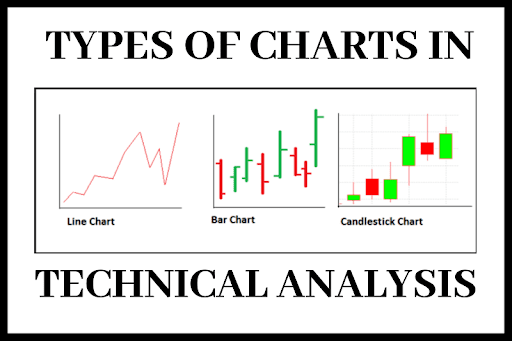
Presently, the most effective chart is a line chart that displays time-series data. In stock markets, historical data plays an important role in making the line chart show the developing past trends. Technical analysis consists of some of the most important chart types such as – candlestick charts, line charts, point and figure charts, bar charts Renko charts etc. Among all the charts, the use of a candlestick chart is highly preferred and has developed a standard to generate price actions.
3. Top 5 Types of Technical Analysis Charts
3.1 Line Charts
3.1.1 Definition
A line chart is a basic chart that depicts information through the line segments for the change in value over time. It is used to track the changes going on for a short and long periods.
3.1.2 History
According to historical aspects, the invention of charts was credited to William Playfair. He used line charts to track the changes by connecting them with a straight line. There were 43-line chart variants developed by William Playfair to explore the data using time and value series.
The question is how the line chart is used to show information in technical analysis of stocks.
Hang in there and read the next…
3.1.3 Use in Technical Analysis
A line chart is the most basic and common chart used in technical analysis which is represented by a graphical representation of lines and dots. It is quite simple in comparison to other complicated charts.
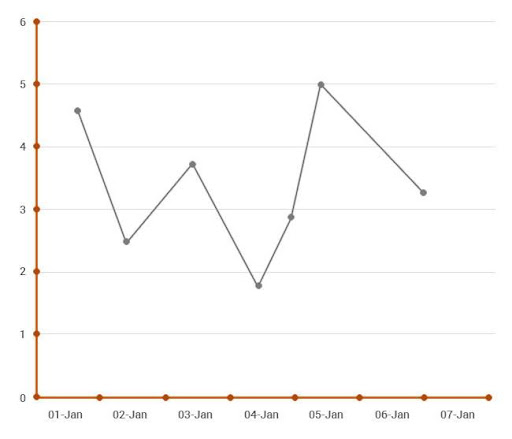
A line chart helps the traders identify the trend and movement of the stock. You can track the dots of the line chart as the closing price which moves to form the line chart. Traders use a line chart to spot and track the closing prices. The closing price is considered is the strongest movement that assists to find strength in a particular stock.
Some of the chart formations in technical analysis such as channel patterns, head and shoulder, and double-top patterns are used to analyse a closing basis view.
3.2 Bar Chart
3.2.1 Definition
A bar chart can be defined as a chart where rectangular bars are used to identify the values that each bar represents.
In technical analysis, a bar chart depicts the prices of security with its open, close, high and low prices.
3.2.2 History
A traditional bar chart was invested during the 1700s to perform the analysis of exports and imports of Christmas goods to Scotland. The bar chart was made to compare different years and the goods produced.
The bar chart initiated the connection with technical analysis when traders and investors wanted to analyse and compare a new price each minute. Bar charts are similar to candlestick charts that interpret similar information but in unique ways.
3.2.3 Use in Technical Analysis
Using bar charts you can spot trends, identify opportunities and create categorical data within the form of bars. Generally, analysts and trades use the bar chart to spot volatile movements.
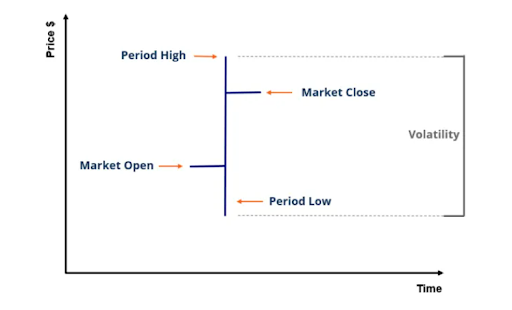
When you open a bar chart you see comparative and distinctive sizes of bars that indicate the opening and closing prices of the security. In a bar chart, the vertical line indicates the prices – high and low, whereas the horizontal line marks the market opening and closing prices.
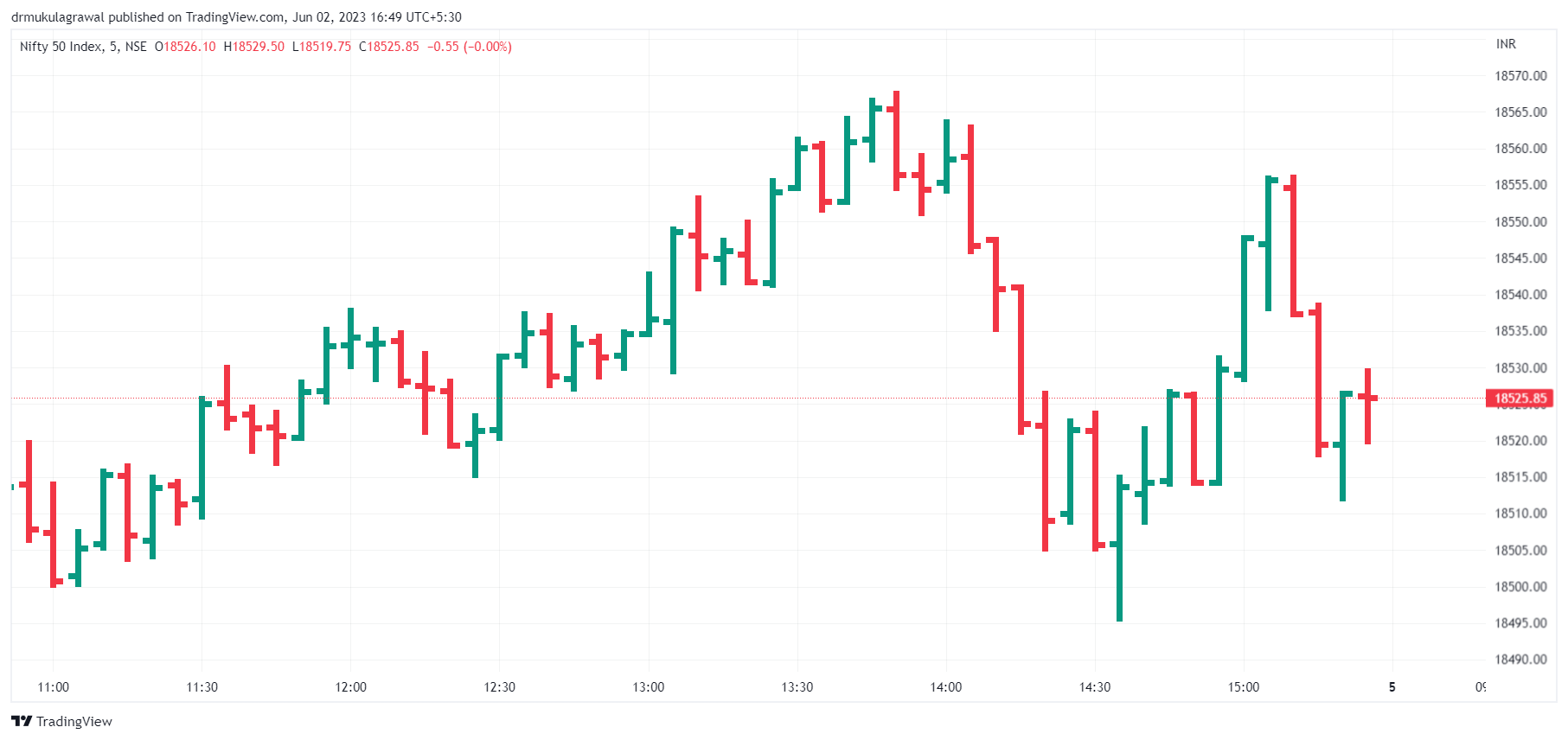
In a bar chart, when the price of a security declines, the bars tend to get longer which means there is high volatility. On the other hand, if the price rises, there should be longer green bars that increase in an increasing pattern. Declines are usually marked with red bars and upward movements are marked with green bars.
3.3 Candlestick Chart
3.3.1 Definition
A candlestick chart is also known as a Japanese candlestick chart or K-line is used to analyse the past trends of an asset or security. It is a method of representation that represents the movement and stability of the stock.
3.3.2 History
As we know, Technical analysis was introduced by Charles Dow during the late 1800s, but chart analysis was not invented until Munehisa Homma – a Japanese rice trader decided to use a candlestick chart to trade rice. He represented the prices graphically on the charts and analysed the concept of candlestick patterns chart. Eventually, the patterns and ideas started building too many candlestick patterns.
3.3.3 Use in Technical Analysis
A candlestick pattern in technical analysis is of utmost importance because it recognized the movement of the stock price. Traders use candlestick patterns to track and predict the price of the security.
A candle shows high, low, open and close prices and is of two colors- red candles refer to the bearish movement and green candles refer to the bullish movement. There are different kinds of candles that are created during the price movement of a security or an asset. But some of the powerful candles are:
-
Doji
-
Dragonfly Doji
-
Hammer
-
Bullish Engulfing
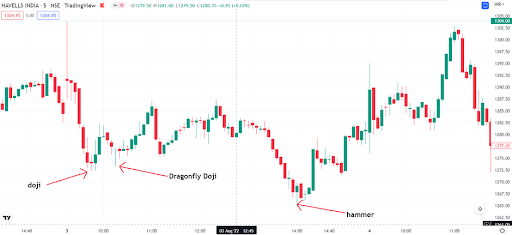
Candlesticks use past trends and common happenings of a chart to predict future trends. It is one of the essential chart patterns to understand and trade in stock markets.
3.4 Renko Chart
3.4.1 Definition
A Renko chart is a type of chart which is developed to analyse price movement by ignoring time-factor. Renko is not well-known among newbie traders. Although, it is used by professional traders.
3.4.2 History
Renko chart is one of the oldest charts invented by the Japanese more than 100 years ago. The name ‘Renko’ was given from the word for bricks ‘renga’. These charts do not consider time while representing a stock price.
3.4.3 Use in Technical Analysis
In technical analysis, the Renko chart is used by traders that prefer to enter and make an exit in the larger trends. In the words of normal traders, the larger the pattern, the larger will be the trend.
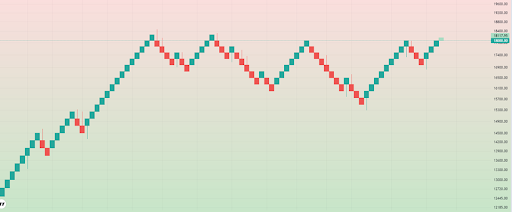
A significant buying or selling pressure is created in the markets which invites the larger value traders to make an entry. This is when traders use the Renko charts to analyse the pressure and volume.
How Renko charts works?
Renko charts, if used correctly, completely render the confusion among traders about the price direction. This type of chart is created using Renko bricks that form the direction with the market price.
3.4.4 How can a professional trend benefit from Renko charts?
-
Patterns like triangles, head and shoulders, tops or bottoms are easier to analyze through Renko charts and save time for traders
-
Renko charts help in forming trailing stop-loss with the ongoing trend. It helps the trader to sustain the share buy or share sell during the movement.
3.5 Point and Figure Charts
3.5.1 Definition
A point and figure chart are useful to filter out the nominal and short trends from the market by figuring out the market noise. It is known as a ‘timeless tool’ because it focuses on price movement analysis rather than past trends.
3.5.2 History
The technique to develop Point and Figure charts were analysed first by Hoyle in one of his books named – The Game in Wall Street 1898. Mostly, the detail of the chart is portrayed by several writers in their technical books.
3.5.3 Use in Technical Analysis
By now, I am sure you must be friendly with the topic – support and resistance, breakouts and other technical terms required during analysis.
In technical analysis, I am sure that you can ensure price movements through several charts that help in developing support and resistance levels. Some traders argue that point and figure charts are more beneficial chart as it filters out the duplicate movements that cause false breakouts.
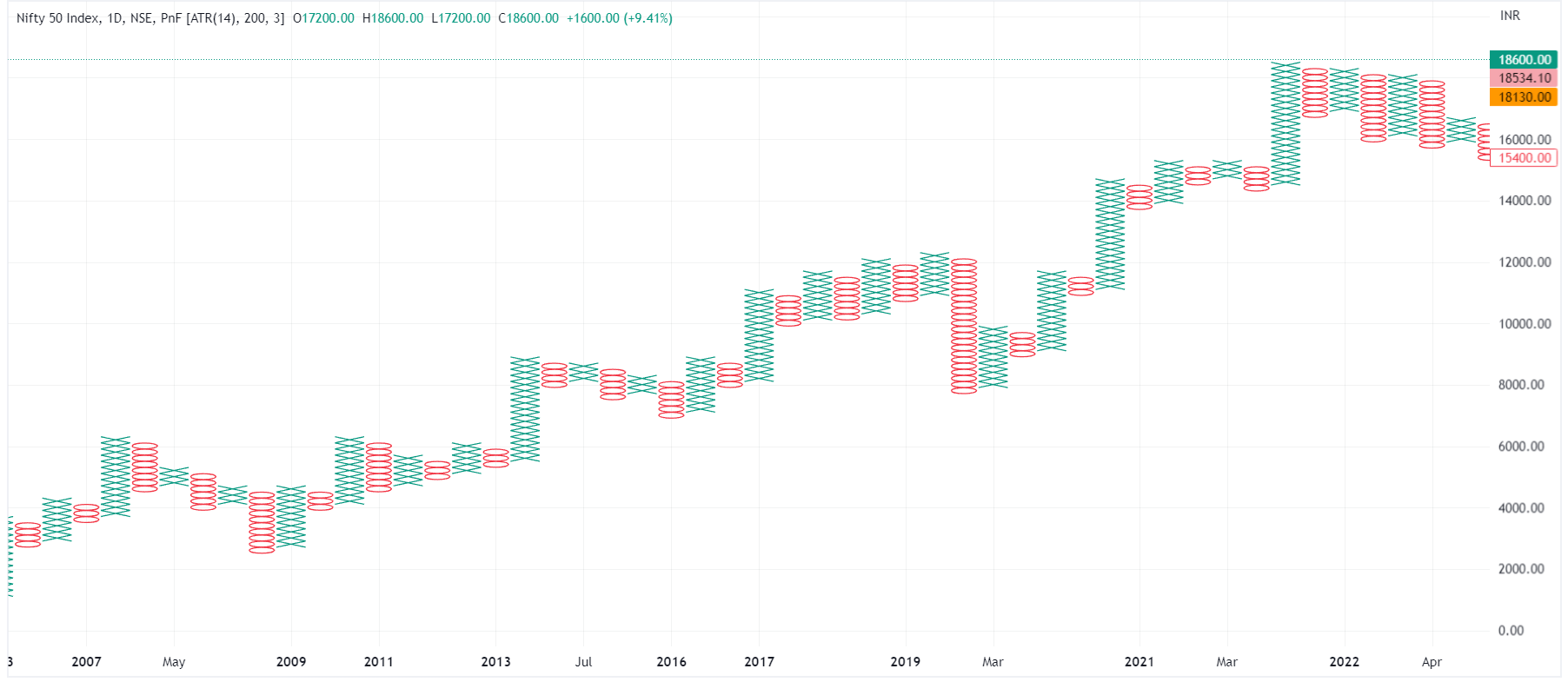
Point and figure chart mark the degree of security by analysing its charts from the columns X and O. Each of the columns represents price movement –
-
X represents the rising price
-
O represent the falling price
The point and figure chart are analyzed through two variables of the set – X and O. The first variable is developed when the price moves higher by the amount which is set, known as box price. The second variable is formed when the price drops below the amount set in the box.
Final Words
In this article, you learned that there are several kinds of technical charts stocks in existence based on security and asset price. Although, there are a few common among traders which are used by them to perform trades- Line, Bar, Candlesticks, Point and Figure and Renko.
Key Takeaways
-
Traders and investors use charts to forecast, evaluate, maintain, and grow market trends.
-
A bar chart, used in technical analysis, shows the open, close, high, and low prices of securities.
-
The Doji, dragonfly doji, hammer, and bullish engulfing candles are among the most potent candlestick patterns for candlestick charts.
-
In a bar chart, the horizontal line denotes the market's opening and closing values, while the vertical line shows high and low prices.
-
Point and figure charts are more useful since they eliminate the repeated movements that lead to false breakouts.
-
Renko charts make it simpler for traders to interpret patterns like triangles, head and shoulders, tops, and bottoms.
-
A line chart is used by traders to identify and monitor closing prices. The strongest movement that aids in identifying strength in a particular stock is said to be the closing price.



